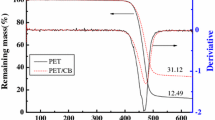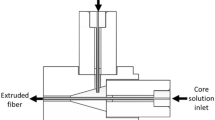Abstract
Microfibers can be obtained by bicomponent spinning, followed by subsequent mechanical splitting. During process, two materials are coextruded in a die to form a unique complex morphology. Many factors affect these morphologies: melt viscosity and difference of crystallization temperature combined with polymers position. Consequently, fiber splitting can be improved by choosing an association of polymers with a stable interface and a poor adhesion. The aim of this study is to understand which intrinsic parameters of polymers allow to enhance bicomponent fiber's splitting. Bicomponent fibers (side-by-side and sheath/core) have been made with two grades of polypropylene and polyamide 6. Instable interface happens when a low-viscosity polymer flows around and encapsulates a high-viscosity material. Possible mechanism responsible of interface deformation is variation of shear rates through the morphology (highest shear rate is at the fiber periphery). DMA analysis reveals that fiber with polyamide as core exceeds the strength of fiber with polyamide as sheath. This increase of strength can be attributed to a better adhesion than fibers with PA6 in sheath. From experimental results, the position combined with the difference crystallization temperature shows poor or strong interface.







Similar content being viewed by others
References
C.D. Han, Multiphase Flow in Polymer Processing, Academic Press, New York, 1981
A. Cayla, C. Campagne, M. Rochery, and E. Devaux, Melt Spun Multifilament Yarns of Carbon Nanotubes-Based Polymeric Blends: Electrical, Mechanical and Thermal Properties, Synth. Met., 2012, 162(1–2), p 759–767
M. Dasdemir, B. Maze, N. Anantharamaiah, and B. Pourdeyhimi, Influence of Polymer Type, Composition, and Interface on the Structural and Mechanical Properties of Core/Sheath Type Bicomponent Nonwoven Fibers, J. Mater. Sci., 2012, 47, p 14
M.S. Ndaro, X. Jin, T. Chen, and C. Yu, Splitting of Islands-in-the-Sea Fibers (PA6/COPET) During Hydroentangling of Nonwovens, J. Eng. Fibers Fabr., 2007, 2(4), p 9
S. Jeffrey et al.US Patent 6,461,729 B1, 2002
J.H. Southern and R.L. Ballman, Additional Observations on Stratified Bicomponent Flow of Polymer Melts in a Tube, J. Polym. Sci., 1975, 13, p 863–869
J. Dooley and L. Rudolph, Viscous and Elastic Effects in Polymer Coextrusion, J. Plast. Film Sheeting, 2003, 19, p 12
C.D. Han, A Study of Bicomponent Coextrusion of Molten Polymers, J. Appl. Polym. Sci., 1973, 17, p 1289–1303
S. Arvidson, K. Wong, R. Gorga, and S. Khan, Structure, Molecular Orientation, and Resultant Mechanical Properties in Core/Sheath Poly(lactic acid)/Polypropylene Composites, J. Mater. Sci., 2012, 53, p 791–800
S. Houis, M. Schmid, and J. Lübben, New Functional Bicomponent Fibers with Core/Sheath-Configuration Using Poly(phenylene sulfide) and Poly(Ethylene Terephthalate), J. Appl. Polym. Sci., 2007, 106, p 1757–1767
W.P. Cox and E.H. Merz, Correlation of Dynamic and Steady Flow Viscosities, J. Polym. Sci., 1958, 27, p 619–622
J.R. Wagner, Polymer Selection for Coextrusion, Extrusion—The Definitive Processing Guide and Handbook: A volume in Plastics Design Library, 2014, p 477–486
A. Karagiannis, H. Mavridis, A.N. Hrymak, and J. Vlachopoulos, Interface Determination in Bicomponent Extrusion, Polym. Eng. Sci., 1988, 28, p 982–988
R.H. Boyd, Relaxation Processes in Crystalline Polymers: Molecular Interpretation—A Review, Polymer, 1985, 26, p 1123–1133
R. Faria, J. Duncan, and R. Brereton, Dynamic Mechanical Analysis and Chemometrics for Polymer Identification, Polym. Test., 2007, 26, p 402–412
C.Q. Sun, D. Zhang, Y. Liu, and R. Xiao, Preliminary Study on Fiber Splitting of Bicomponent Meltblown Fibers, J. Appl. Polym. Sci., 2004, 93, p 2090–2094
Acknowledgment
This work was supported by research grants FUI 14 and approved by Up-Tex. We thank Severine Bellayer from UMET (ENSCL) for SEM experimentation.
Author information
Authors and Affiliations
Corresponding author
Additional information
This article is an invited submission to JMEP selected from presentations at the Symposium “Interface Design and Modelling,” belonging to the Topic “Joining and Interfaces” at the European Congress and Exhibition on Advanced Materials and Processes (EUROMAT 2015), held September 20-24, 2015, in Warsaw, Poland, and has been expanded from the original presentation.
Rights and permissions
About this article
Cite this article
Ayad, E., Cayla, A., Rault, F. et al. Influence of Rheological and Thermal Properties of Polymers During Melt Spinning on Bicomponent Fiber Morphology. J. of Materi Eng and Perform 25, 3296–3302 (2016). https://doi.org/10.1007/s11665-016-2193-2
Received:
Revised:
Published:
Issue Date:
DOI: https://doi.org/10.1007/s11665-016-2193-2




